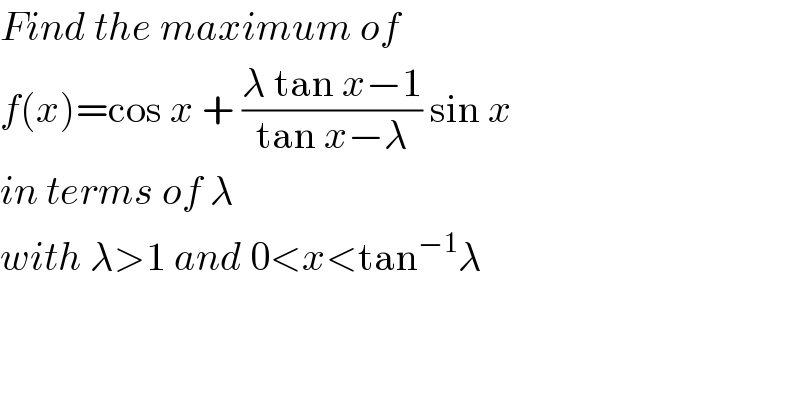
Question Number 48739 by mr W last updated on 28/Nov/18

$${Find}\:{the}\:{maximum}\:{of} \\ $$ $${f}\left({x}\right)=\mathrm{cos}\:{x}\:+\:\frac{\lambda\:\mathrm{tan}\:{x}−\mathrm{1}}{\mathrm{tan}\:{x}−\lambda}\:\mathrm{sin}\:{x} \\ $$ $${in}\:{terms}\:{of}\:\lambda \\ $$ $${with}\:\lambda>\mathrm{1}\:{and}\:\mathrm{0}<{x}<\mathrm{tan}^{−\mathrm{1}} \lambda \\ $$
Answered by MJS last updated on 28/Nov/18

$${f}\left({x}\right)=\lambda\frac{\mathrm{cos}\:\mathrm{2}{x}}{\lambda\mathrm{cos}\:{x}\:−\mathrm{sin}\:{x}} \\ $$ $${x}=\mathrm{arctan}\:{t}\:\Rightarrow\:\mathrm{cos}\:{x}\:=\frac{\mathrm{1}}{\sqrt{{t}^{\mathrm{2}} +\mathrm{1}}};\:\mathrm{sin}\:{x}\:=\frac{{t}}{\sqrt{{t}^{\mathrm{2}} +\mathrm{1}}} \\ $$ $${f}\left({t}\right)=\lambda\frac{\left({t}−\mathrm{1}\right)\left({t}+\mathrm{1}\right)}{\left({t}−\lambda\right)\sqrt{{t}^{\mathrm{2}} +\mathrm{1}}} \\ $$ $${f}'\left({t}\right)=−\lambda\frac{\lambda{t}^{\mathrm{3}} −\mathrm{3}{t}^{\mathrm{2}} +\mathrm{3}\lambda{t}−\mathrm{1}}{\left({t}−\lambda\right)\left({t}^{\mathrm{2}} +\mathrm{1}\right)^{\mathrm{3}/\mathrm{2}} } \\ $$ $${t}^{\mathrm{3}} −\frac{\mathrm{3}}{\lambda}{t}^{\mathrm{2}} +\mathrm{3}{t}−\frac{\mathrm{1}}{\lambda}=\mathrm{0} \\ $$ $${t}={z}+\frac{\mathrm{1}}{\lambda} \\ $$ $${z}^{\mathrm{3}} +\frac{\mathrm{3}\left(\lambda^{\mathrm{2}} −\mathrm{1}\right)}{\lambda^{\mathrm{2}} }{z}+\frac{\mathrm{2}\left(\lambda^{\mathrm{2}} −\mathrm{1}\right)}{\lambda^{\mathrm{3}} }=\mathrm{0} \\ $$ $${D}=\frac{\left(\lambda^{\mathrm{2}} −\mathrm{1}\right)^{\mathrm{2}} }{\lambda^{\mathrm{4}} }\geqslant\mathrm{0}\mid\lambda\in\mathbb{R} \\ $$ $${z}_{\mathrm{1}} =\frac{\sqrt[{\mathrm{3}}]{\lambda^{\mathrm{2}} −\mathrm{1}}}{\lambda}\left(\sqrt[{\mathrm{3}}]{\lambda−\mathrm{1}}−\sqrt[{\mathrm{3}}]{\lambda+\mathrm{1}}\right) \\ $$ $${t}_{\mathrm{1}} ={z}_{\mathrm{1}} +\frac{\mathrm{1}}{\lambda}=\frac{\mathrm{1}}{\lambda}\left(\mathrm{1}+\sqrt[{\mathrm{3}}]{\lambda^{\mathrm{2}} −\mathrm{1}}\left(\sqrt[{\mathrm{3}}]{\lambda−\mathrm{1}}−\sqrt[{\mathrm{3}}]{\lambda+\mathrm{1}}\right)\right) \\ $$ $${x}_{\mathrm{1}} =\mathrm{arctan}\:\left(\frac{\mathrm{1}}{\lambda}\left(\mathrm{1}+\sqrt[{\mathrm{3}}]{\lambda^{\mathrm{2}} −\mathrm{1}}\left(\sqrt[{\mathrm{3}}]{\lambda−\mathrm{1}}−\sqrt[{\mathrm{3}}]{\lambda+\mathrm{1}}\right)\right)\right) \\ $$
Commented bymr W last updated on 28/Nov/18

$${thank}\:{you}\:{sir}! \\ $$ $${it}'{s}\:{correct}\:{and}\:{perfect}!\:{great}\:{job}! \\ $$
